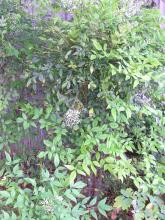
High Plains Gardening
The gardening website of the Texas High Plains Region

Nandina is one of a few single species genera, a member of the barberry family (Berberidaceae). Though one species, several cultivars are available to add texture and interest to our low maintenance, low water-use landscape in either sun or shade. I plant mine in full shade, as there are few shrubs that will flower there. I personally favor protecting Nandina with afternoon shade, if planted in a sunny location.
However, Nandina is used extensively throughout the southwest where temperatures are considerably hotter than ours. Noted to be a Zone 7 plant, heavenly bamboo has been grown in Amarillo for as long as I can remember, and has been evergreen for me. As you might guess from its appearance, it is native to areas from India to Japan, and provides that touch of the exotic or Oriental, we all appreciate in our gardens.
Nandina is a four-seasons of interest shrub, staying evergreen nearly the entire year. it puts on white flowers in late spring and red berries in late fall that last into the winter. Nandina pairs well with Caryopteris, Aquilegias, Mahonias, Cornus drummondii, Pavonia lasiopetala, native geraniums and heucheras (coral bells).
If Nandina becomes top heavy with limited foliage at the base, judicially prune a few stems each year at late winter to rejuvenate lower growth. Always prune shrubs down to the base.
Any where from sun to shade, dry to moist. Completely versatile shrub! I use it mostly in shaded areas. Shrub beds or borders, on the north side of a home, woodland garden, Japanese-style garden. Container garden.
Topdress with 1 inch compost spring and fall. If pruning is needed due to a top heavy appearance, do not prune out more than 20% of the stems in any one year. Prune stem out at the base.